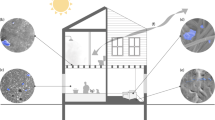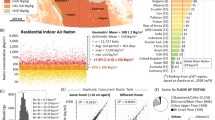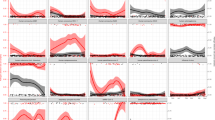Abstract
We evaluated attenuation in linear associations between microbial exposure and respiratory symptoms occurring when individual measurements of microbial agents were used for estimating employees’ exposure compared with group means. Symptoms, which improved when away from the building (building-related, BR), and measurements of culturable fungi, ergosterol, and endotoxin in floor dust were obtained between 2001 and 2007 from four cross-sectional studies on occupants of a water-damaged building. We compared odds ratios from longitudinal health effect models using individual measurements at employees’ workstations with those using floor (group) means. Estimated odds for BR respiratory symptoms in group-based analyses increased by 2 to 5 times compared with those from individual-based analyses for culturable fungi and ergosterol, although they were less precise. For endotoxin, we found substantially increased and significant odds in group-based analyses, while we found no associations in individual-based analyses for various symptoms. Our study suggested that the building floor was useful in constructing exposure groups for microbial agents in this water-damaged building for epidemiologic analysis. Our study showed that group-average exposure estimation provides less attenuated associations between exposures to microbial agents and health in damp indoor environments where measurement error and intrinsic temporal variability are often large.
This is a preview of subscription content, access via your institution
Access options
Subscribe to this journal
Receive 6 print issues and online access
$259.00 per year
only $43.17 per issue
Buy this article
- Purchase on Springer Link
- Instant access to full article PDF
Prices may be subject to local taxes which are calculated during checkout





Similar content being viewed by others
References
Seixas NS, Sheppard L . Maximizing accuracy and precision using individual and grouped exposure assessments. Scand J Work Environ Health 1996; 22: 94–101.
Tielemans E, Kupper LL, Kromhout H, Heederik D, Houba R . Individual-based and group-based occupational exposure assessment: some equations to evaluate different strategies. Ann Occup Hyg 1998; 42: 115–119.
Park J-H, Cox-Ganser JM, Kreiss K, White SK, Rao CY . Hydrophilic fungi and ergosterol associated with respiratory illness in a water-damaged building. Environ Health Perspect 2008; 116: 45–50.
Rappaport SM, Kupper LL . Exposure measurement errors. In:. Quantitative Exposure Assessment. Stephen Rappaport El Cerrito, CA. 2008 pp. 111–125.
Kim HM, Richardson D, Loomis D, Van TM, Burstyn I . Bias in the estimation of exposure effects with individual- or group-based exposure assessment. J Expo Sci Environ Epidemiol 2011; 21: 212–221.
Kromhout H, Heederik D . Occupational epidemiology in the rubber industry: implications of exposure variability. Am J Ind Med 1995; 27: 171–185.
Kromhout H, Tielemans E, Preller L, Heederik D . Estimates of individual dose from current measurements of exposure. Occup Hyg 1996; 3: 23–39.
Johannesson S, Rappaport SM, Sallsten G . Variability of environmental exposure to fine particles, black smoke, and trace elements among a Swedish population. J Expo Sci Environ Epidemiol 2011; 21: 506–514.
Teschke K, Spierings J, Marion SA, Demers PA, Davies HW, Kennedy SM . Reducing attenuation in exposure-response relationships by exposure modeling and grouping: the relationship between wood dust exposure and lung function. Am J Ind Med 2004; 46: 663–667.
Rappaport SM, Kromhout H, Symanski E . Variation of exposure between workers in homogeneous exposure groups. Am Ind Hyg Assoc J 1993; 54: 654–662.
Institute of Medicine of the National Academies Exposure assessment. In:. Committee on Damp Indoor Spaces and Health. The National Academies Press Washington, D.C.. 2004 pp. 90–124.
World Health Organization Health effects associated with dampness and mould. In:. WHO Guidelines for Indoor Air Quality: Dampness and Mould. WHO Regional Office for Europe Copenhagen. 2009 pp. 63–96.
Sahakian NM, Park J-H, Cox-Ganser JM . Dampness and mold in the indoor environment: implications for asthma. Immunol Allergy Clin North Am 2008; 28: 485–505.
Park J-H, Cox-Ganser JM, Rao C, Kreiss K . Fungal and endotoxin measurements in dust associated with respiratory symptoms in a water-damaged office building. Indoor Air 2006; 16: 192–203.
Cox-Ganser JM, White SK, Jones R, Hilsbos K, Storey E, Enright PL et al Respiratory morbidity in office workers in a water-damaged building. Environ Health Perspect 2005; 113: 485–490.
Iossifova YY, Cox-Ganser JM, Park J-H, White SK, Kreiss K . Lack of respiratory improvement following remediation of a water-damaged office building. Am J Ind Med 2011; 54: 269–277.
Cho SJ, Park J-H, Kreiss K, Cox-Ganser JM . Levels of microbial agents in floor dust during remediation of a water-damaged office building. Indoor Air 2011; 21: 417–426.
Vermeulen R, Kromhout H . Historical limitations of determinant based exposure groupings in the rubber manufacturing industry. Occup Environ Med 2005; 62: 793–799.
Peretz C, Goren A, Smid T, Kromhout H . Application of mixed-effects models for exposure assessment. Ann Occup Hyg 2002; 46: 69–77.
Weaver MA, Kupper LL, Taylor D, Kromhout H, Susi P, Rappaport SM . Simultaneous assessment of occupational exposures from multiple worker groups. Ann Occup Hyg 2001; 45: 525–542.
Littell RC, Milliken GA, Stroup WW, Wolfinger RD, Schabenberger O . Generalized linear mixed models. In:. SAS® for Mixed Models. SAS Institute Cary, NC. 2006 pp. 525–566.
Desquilbet L, Mariotti F . Dose-response analyses using restricted cubic spline functions in public health research. Stat Med 2010; 29: 1037–1057.
Armstrong BG . Effect of measurement error on epidemiological studies of environmental and occupational exposures. Occup Environ Med 1998; 55: 651–656.
Park J-H, Spiegelman DL, Burge HA, Gold DR, Chew GL, Milton DK . Longitudinal study of dust and airborne endotoxin in the home. Environ Health Perspect 2000; 108: 1023–1028.
Cho SJ, Ramachandran G, Grengs J, Ryan AD, Eberly LE, Adgate JL . Longitudinal evaluation of allergen and culturable fungal concentrations in inner-city households. J Occup Environ Hyg 2008; 5: 107–118.
Park J-H, Kreiss K, Cox-Ganser JM . Rhinosinusitis and mold as risk factors for asthma symptoms in occupants of a water-damaged building. Indoor Air 2012 e-pub ahead of print 21 March 2012, doi:110.1111/j.1600-0668.2012.00775.x.
Carroll RJ, Ruppert D, Stefanski LA . Regression and attenuation. In:. Measurement Error in Nonlinear Models. Champman & Hall London, UK. 1995 pp. 21–39.
Acknowledgements
We thank Dr. Mark Hoover and Dr. M. Abbas Virji for carefully reviewing our manuscript. We are also grateful to our colleagues for collecting environmental samples and health questionnaire data and all study participants, agency management, and labor unions in the building. The findings and conclusions in this report are those of the authors and do not necessarily represent the views of the National Institute for Occupational Safety and Health.
Author information
Authors and Affiliations
Corresponding author
Ethics declarations
Competing interests
The authors declare no conflict of interest.
Additional information
Supplementary Information accompanies the paper on the Journal of Exposure Science and Environmental Epidemiology website
Supplementary information
Rights and permissions
About this article
Cite this article
Cho, S., Cox-Ganser, J., Kreiss, K. et al. Evaluation of individual-based and group-based exposure estimation of microbial agents in health effects associated with a damp building. J Expo Sci Environ Epidemiol 23, 409–415 (2013). https://doi.org/10.1038/jes.2012.89
Received:
Accepted:
Published:
Issue Date:
DOI: https://doi.org/10.1038/jes.2012.89



